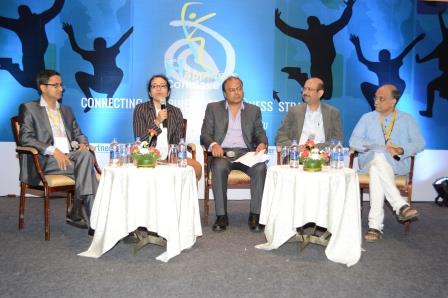While employee happiness is intrinsic to employees, employee engagement is driven by the employer. How can the two be juxtaposed to create a utopian culture?
The very first session of The Happiness Conclave, organised by HRKatha at Taj Vivanta, Bengaluru, on April 29, 2016, pondered over what is more important— ‘Employee Happiness’ or ‘Employee Engagement’?
The panellists of the session were Jayesh Pandey, managing director – strategy, talent & organisation, Accenture; Rajesh Padmanabhan, director & group CHRO, Welspun Group; Sudheesh Venkatesh, chief people officer, Azim Premji Foundation and Anil Kumar Misra, CHRO, Fidelity National Financial. The session was moderated by Rituparna Chakraborty, co-founder, Team Lease.
Chakraborty initiated the discussion by outlining that happiness is intrinsic, and that it lies in the self-esteem of an individual.
Pandey referred to the results of a recent analytical study by Accenture, and raised three interesting observations:

• If there was a positive emotion, such as happiness, any change, irrespective of the dangers surrounding the same, would always yield a positive result.
• In cases involving positive emotions around a specific change —be it any strategy or business model—there was a higher amount of trust in the senior leadership, among the second and third lines of leadership.
• In all organisations where the focus was on employee’s individual well-being, the positive emotion was high.
Summarising his views, Pandey said that there is a very strong link between employee well-being and the desires and actions of the employer. When the trust in the supervisor or the senior member of the team is high, the emotion is positive. This positive emotion is evident when the gap between what employees deserve and what they desire is narrow.

Padmanabhan had an interesting view on ‘happiness at work’. According to him, happiness meant being in the moment and living in the present, despite past and future dreams.
He opined that people bring their holistic self to work. This implies that their heart, mind, body and soul work together in myriad ways, and the outcome is in the form of their behaviour. When all these four work in tandem, the result is happiness.
From an employer’s point of view, most of the organisations and HR folk have mastered the skill of dealing with the heart, mind and physical environment needs of the employees, in the best possible way. But now, more and more companies are realizing that they also need to address the requirements of the soul. Therefore, values and culture will play a very significant role in organisations.

Stressing on the purpose of creating happiness, Padmanabhan pointed out that since the four Ps — policies, processes, performance and practices— have been perfected, it is time to focus on the fifth ‘P’, that is, ‘purpose’. He added that organisations need to show respect to employees and also change from being ‘telling’ organisations to ‘listening’ ones, to ensure more happiness amongst employees.
Speaking next, Venkatesh left the audience with some food for thought. The first point he raised was that it was futile to aim at happiness, as the more one targets it, the more the chances of missing the target. So, like success, one cannot pursue happiness. It can only ensue.
Quoting a Kannada litterateur, Venkatesh said that sources of happiness will vary and so will the meaning of happiness in different stages.
The third point he raised was that fancy workplaces and freebies do not make employees happy. Instead, the companies should work on getting the basics right —creating better jobs, appreciation practices, regular and constructive feedback, clear growth paths, creating an environment of trust and respect, and giving more praise than criticism. These are the things that matter most to the employees.
Venkatesh made a few very important statements that the panel and audience took note of. He stated that it wasn’t necessary for HR to drive employee happiness. Also, it was ethically wrong for companies to influence an individual’s state of happiness.
The question he posed was, when it is difficult to measure the return on happiness— due to lack of scientific data to support the claim that happy employees means better productivity— should we focus on it at all?

The last speaker, Misra, started by sharing his understanding of both the terms —‘employee engagement’ and ‘employee happiness’. According to him, employee engagement was an individual employee’s emotional commitment to an organisation. Employee happiness, on the other hand, was the measure of employee satisfaction—with regard to the job and the conditions related to it.
He pointed out that respect for an employee’s individuality, trust between employees and the top management, and lastly, the compensation and related benefits, were the triggers of happiness, in the same chronological order. He stressed on the importance of work environment and culture, because of which people like coming back to the workplace.

Taking the discussion further, Chakraborty left an open question for the panel —If trust was a major trigger of happiness, what should companies do to build that trust?
Pandey responded that respect for an individual through day-to-day transactions led to trust. Every person should be treated with respect and be given a patient hearing, irrespective of the individual’s position, to build a culture of trust. The leaders of the organisation should lead from the front and walk the talk to ensure that the values they preach do not just remain on pen on paper.
(The Happiness Conclave organised by HR Katha was held at Taj Vivanta, Bengaluru, on April 29, 2016. The sponsors and partners for this event were The Fuller Life, NHRDN-Bengaluru Chapter, PeopleWorks, Giftxoxo and Kommune Brand Communications.)



